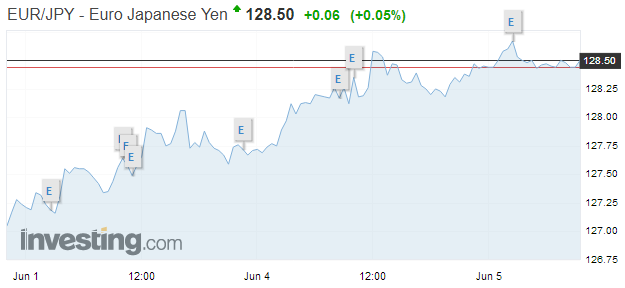The euro put in a low on May 29 a little above $1.15. That is nearly a 10.5 cent decline since the three-year high was set in mid-February. The thing that is difficult for investors and analysts to get their head around is that the speculators in the futures market, who as seen as proxies for trend-followers and momentum traders, continue to carry large euro exposure.
Too many observers mistakenly focus on the net positions in the futures market. Since late-April, the net speculative long position has been trimmed by a little more than a third (from 151k to 93k contracts). It has fallen for six consecutive weeks and now is at the low for the year. The net position is an abstraction. No one puts on a net position. One is either long or short. The net position combines the two. The gross shorts are vulnerable to a rally, and the gross longs are vulnerable to a sell-off.
Drilling down from the net to the gross positioning is very revealing. The gross euro longs have risen in four of the past five weeks. In the spot market, the euro fell for six consecutive weeks before snapping it last week by rising less than 0.1%. The net position exaggerates the extent to which the euro bulls in the futures market have cut their exposure. At nearly 235k contracts, the speculative community has a larger net long euro position that it had at the end of last year. It rose by around 14k contracts over the course of last month, while spot fell 3.2%. The record, set in late January was a little more than 262k. The latest figures show about an 11% pullback.
What the focus on the net position misses is that it is not the longs that have liquidated, but the new shorts that have been established. The speculative gross short euro position bottomed in late April near 86k contracts. It too has risen four of the past five CFTC reporting periods. It has risen by 51.5k contracts since the end of April.
There is another source of selling that may be weighing on the euro, but not being picked up in the futures positioning. Japanese institutional investors had been strong buyers of European bonds. Now it looks like they are boosting hedge ratios. This seems vaguely similar to the pattern involving the dollar. An under-appreciated factor that drove the dollar higher against the yen was international diversification of the Government Pension Investment Fund (GPIF) and other pension funds. The one-year dollar decline beginning in mid-2015 seemed to correspond to the hedging operations associated with the newly acquired dollar assets.
Reports suggest that Japanese life insurers have been boosting their euro hedge ratios. It is hard to find timely data, but the earnings reports contained such nuggets that cover the period through March. The hedge ratio appears to rise to 76% as of March 2018 from 71% at the end of September 2017. The life insurers are believed to have around JPY11 trillion of euro-denominated bonds. A 5% increase in the hedge ratio would entail the selling of 550 bln euros.
Japanese life insurers appear to have large euro hedge ratios that dollars (53.2% vs. 53.5% last September) and Australian dollars (59.4% vs. 62.4%), according to Bloomberg calculations. This does not necessarily reflect currency views per se. Due to interest rate differentials, Japanese investors get paid to hedge the euro but pay over 200 bp to hedge the US dollar exposure.
Japan’s April balance of payments report that is due on June 7 in Tokyo will update the country allocation of Japanese institutional investors but shed no color on hedges. Over the past six months, Japanese investors have been bigger buyers of French bonds than German (JPY2.09 trillion vs. JPY1.57 trillion) and have generally bought small amounts of 10 of the EMU 12. Life insurers bought s small amount of Italian bonds (JPY52.5 bln) in the six months through March.
Japan Post Insurance Insurance (Kampo) indicated that it had cut its Italian exposure by nearly 2/3 in the run-up to the March election so that it accounted for 1% of its overseas portfolio. Kampo has approximately JPY77 trillion in assets, of which about JPY7 trillion are international. Italy’s share then is about JPY70 bln. However, last week it indicated that it thought the sell-off in Italy’s short-end was overdone and it saw an opportunity to begin rebuilding its position.
| The euro fell to JPY124.60 last week. That is the lowest it has been since mid-2017. The euro’s pullback after reaching JPY137.50 in early February stopped shy of the 50% retracement (~JPY123.55). It is trading higher for the fourth consecutive session. The JPY128.80-JPY129.50 area may slow the recovery. |
EUR/JPY, daily(see more posts on EUR/JPY, ) |
Tags: #USD,$EUR,$JPY,EUR/JPY,newslettersent







































